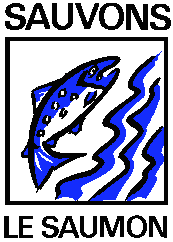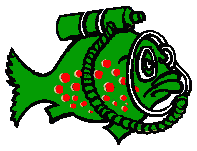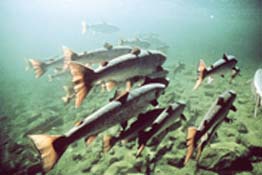
a survivor


|
 |
Atlantic salmon,
a magnificent fish, used to migrate up all main West European rivers,
from the North of Portugal to the Arctic Circle. Nowadays, they
have disappeared from all big rivers, except the Loire and its main
tributary the Allier. This makes the Loire-Allier salmon a unique
fish in Europe : it is now the last genetic stock of large wild
salmon which can be used for reintroducing the species on other
large rivers in France and Europe (Rhine, Garonne, etc.).
Recent
statistics and other news (external site)
 On
the estuary of the Loire river, at the end of the 19th century,
about 10,000 salmon - i.e. an estimated 100 tons - used to be
taken every year. On the upper Allier, before the Saint-Etienne
du Vigan dam was built, the villages of Luc, Langogne and La Bastide
used to export about 10 tons of salmon (approximately 1,000 fish)
to the South of France. Early in the century, anglers used to
come from all over Europe to Brioude to catch salmon on the Allier
river...
On
the estuary of the Loire river, at the end of the 19th century,
about 10,000 salmon - i.e. an estimated 100 tons - used to be
taken every year. On the upper Allier, before the Saint-Etienne
du Vigan dam was built, the villages of Luc, Langogne and La Bastide
used to export about 10 tons of salmon (approximately 1,000 fish)
to the South of France. Early in the century, anglers used to
come from all over Europe to Brioude to catch salmon on the Allier
river...
Dams, the main cause of the decline

A Salmons elevator by Poutès-Monistrol (photo CSP)
.On
the Allier river, the EDF (the Electricity Generating Authority
of France) dam of Saint-Etienne
du Vigan (built in 1895, dismanteld in 1998) has been closing
off for a century about 50 hectares of the best upper basin spawning
grounds, while the Poutès-Monistrol dam (built in 1941)
has totally stopped all migration for half a century, until a
« salmon elevator » was built in 1986. From 1941 to
1986, only 8% of the 2,200 hectares of breeding areas used in
the early 19th century were accessible. As for the Allierís main
tributaries (Sioule, Dore, Allagnon, Chapeauroux), they have all
been almost « sterilized »..
The upper Loire, the access of which became difficult in 1845
when the Decize navigation dam was built, became totally closed
to salmon when the Grangent (1957) and Villerest (1983) dams were
built. On the Vienne-Creuse-Gartempe basin, migration is still
blocked by the EDF dam of Maisons-Rouges
(dismanteld in 1998): salmon disappeared from the Vienne river
in 1930, while the Cher river - another tributary of the Loire
- was « sterilized » as early as 1858.
Apart from dams, salmon must face other problems: silting up and salinization of the Loire estuary, varied obstacles (nuclear plants, bridges...), deepening of the riverbed due to sand quarries, heating up of the water engendered by nuclear plants, excessive fishing, pollution, etc..
The
measures launched by the Plan Grandeur Loire Nature attempt to
improve the situation.
next page
![]()
These pages and their content are © Copyright of European Rivers Network.